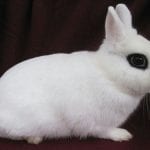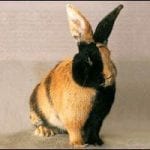Scientific Facts
| Common Name: | English Angora |
| Scientific Name: | Oryctolagus cuniculus |
| Life Span: | 5 to 8 years |
| Size (Adult): | Small, mini |
| Weight (Adult) | 5 to 6 pounds |
| Habitat: | Human homes, farms, gardens. |
| Body Shape: | Compact |
| Country of Origin: | Ankara, Turkey |
Physical Description

The English Angora rabbits are a breed of rabbits that have striking thick and fine fur. These rabbits have small bodies and have a compact built with a flat head and short ears. Sometimes, it’s hard to see what the actual body of an English Angora looks like because it’s mostly hidden underneath the thick fur.
Aside from that luxurious fur all over their bodies, including their feet, hair is also found on their faces. This is what’s different from an English Angora with other Angora breeds.
Coat and colors
The English Angora is the only breed of Angora rabbits with facial hair. They have very dense bands and side trimmings that their entire body, as well as their feet, are covered with thick fur. Dubbed as the ‘’round balls of fluff,’’ English Angoras that are well-cared for with well-maintained coats are usually the best in the show in any rabbit contest.
The English Angora coat is very thick, wooly, and silky when touched. This needs regular grooming even if the rabbit is just resting or during off-periods. If grooming and brushing are overlooked, their fur becomes tangled, matted, and dirty, and this is very hard to remove. So whether you are raising an English Angora as a show rabbit, as a wool producer, or just a pet, this needs regular grooming using the right grooming tools.
You can take an Angora to a groomer for expert grooming and styling, or you can learn how to groom your rabbit. People who harvest wool from their pet English Angoras have reported shedding at least four times a year. A ‘’puppy cut’’ is the most preferred cut for a pet English Angora. This cut involves cutting hair that is on their faces and some on their feet but allowing the rest of the body fur to grow.
English Angoras are available in a variety of colors. The first is the agouti group classified as lynx, chocolate, and chestnut. The self group is rabbits that have black, blue, lilac, and chocolate as well as the shaded group in black tort, blue tort, chocolate tort, and lilac tort.
When it comes to showing class, rabbits are classified as having ruby red eyes and a white coat. Finally, there is the pointed group with either white, white, black spots on the legs and nose, white wool with brown spots on the nose and legs, and the white wool with grey spots along the legs and nose.
History of the Breed
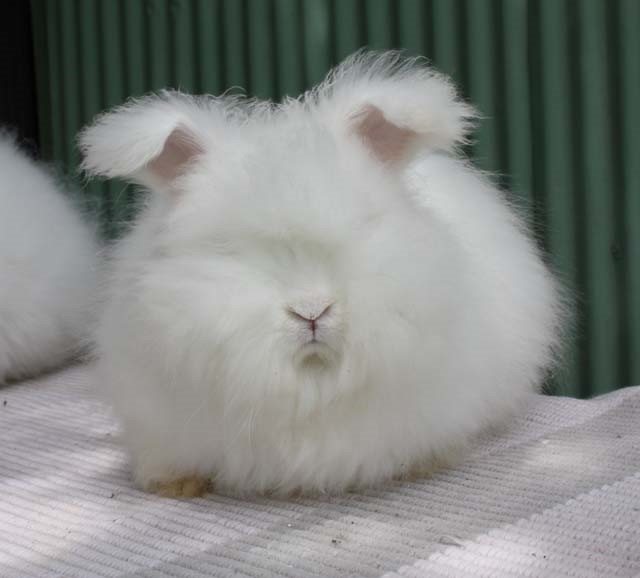
The English Angora rabbit breed is one of the breeds of the Angora rabbit. The Angora is known as one of the oldest domestic rabbit breeds that originated from Ankara, Turley. This breed made its way to the USA before 1939 and had only one type of Angora called the woolly rabbits known as the ”Angola Wooler.’’
In the US, the Angola Wooler ’ was further re-classified into two kinds of rabbits called the French and the English. The ARBA has further classified the Angora as the breed we know today: the French Angora breed and the English Angora breed.
Fast Facts
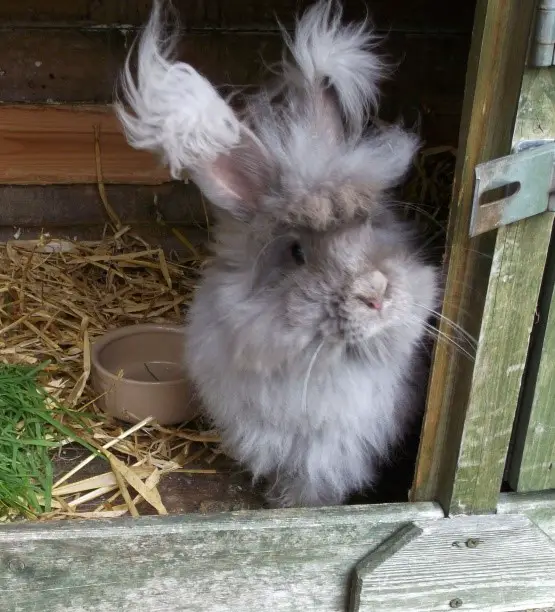
English Angoras have the most fanciful ears. These are ears that stand straight in V formation but are all covered with fur from the head to the tip. Inside, the ears are also lined with fur but are not as thick as the outside part of the ear.
As an English Angora owner, you must learn how to cut your pet’s hair, especially its facial hair. Usually, this starts with training your pet to trust you before you hold and cut its fur with sharp scissors! In short, never attempt to groom an English Angora that is not calm and trusting.
Reproduction

You might think that because of all that fur, English Angora rabbits will have a hard time to breed and mate, right? Well, breeding and mating English Angoras are just the same as other rabbit breeds. First, the female is introduced to the cage of the male, and the two will run after each other and smell each other to get to know each other better.
The female will lie down or remain still once it submits to the male. The male will sense her submission and smell her chin and hindquarters and will proceed with mounting her if there are no qualms. Mating happens quickly, and you’ll know when it’s over when the male lets the female alone.
After successfully mating, the female is transferred to her cage, where a nesting box will be placed later. Gestation lasts up to 38 days, more or less, and you’ll know that the female is about to give birth once she develops a poor appetite and also will refuse to eat. She will soon become very agitated, and this is a sure sign that the babies are nearly born.
The soon to be a mother will look for a suitable nest. She will use hay and her fur to make a very luxurious, waterproof, and warm nest for here lucky babies. You can also offer a nesting box, a simple box lined with hay. She will give birth to 3 to 5 babies. Usually, rabbits have three, four, or five litters per year.
The babies may be born with little hair, are blind, deaf, and helpless. The mother will clean them up and nurse them but will quickly leave the nest. She will first cover the nest with hay to protect her babies from predators. She will return night after night to nurse them. Baby rabbits will open their eyes around 5 to 7 days and will leave the nest and wean from their mother at 10 to 14 days. A rabbit starts to mature and may start to reproduce at 5 to 8 months of age.
Fun Facts
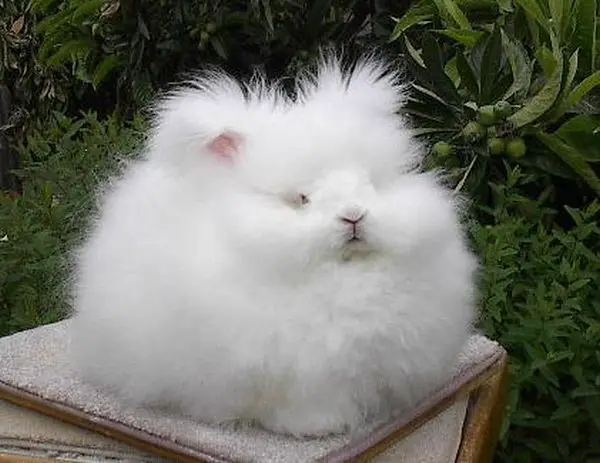
Ask any rabbit contest judge, and they will tell you that the English Angora can be quite a challenge to judge! The wool of the English Angora should be soft and silky, and the guard hairs present but not as visible as the ones in a French Angora. The wool length should be at least two inches, but there are no bonus points for rabbits with wool strands longer than 5 inches.
Top English Angoras can have wool strands that are up to 12 inches long! Also, wool density is very important. An English Angora may be disqualified if it lacks hair on the face, head, or around the ankles and the front legs.
Personality and behavior
English Angoras are even-tempered and love to spend time with other rabbit companions and with their human owners or handlers. The most important bonding moment between an owner and an English Angora is during grooming. So take time to learn how to groom your pet so you’ll develop a trusting bond with your lovely Angora rabbit.
English Angoras are calm and don’t tend to be skittish or aggressive. This breed doesn’t crave a lot of attention, too, and sometimes may just want to simply sit in a corner and chew hay. With these good traits, it is a great bred for families, singles, couples, and for seniors too.
Comparable Breeds
The English Angora is comparable to two popular rabbit breeds: the Satin Angora rabbit and the French Angora rabbit. The Satin Angora rabbit is a medium-sized rabbit that weighs anywhere from 3.5 to 9.5 pounds with a commercial shape. It is a curious breed, friendly, sweet, and sociable, so it’s best suited for families, singles, and couples.
Meanwhile, the French Angora rabbit is a large rabbit breed that weighs from 7.5 to 10.5 pounds and commercial body shape. It has a friendly, gentle, docile and calm temperament which makes it best suited for singles, couples, families, and seniors.
Care of English Angoras
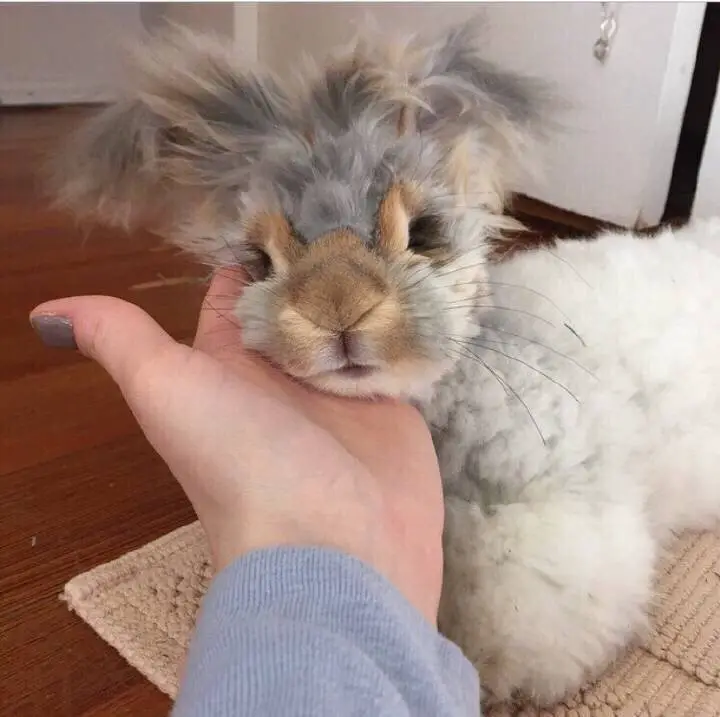
An English Angora may look like a million dollars with its luxurious and soft wool coat, but rest assured, this is very easy to care for. Caring for an English Angora is like caring for other rabbit breeds, as well. You must always make sure you’re your pet has the right diet, housing or enclosure, companionship, and correct medical treatment.
Consider giving your pet hay. It is an important part of a rabbit’s diet, but you may also offer rabbit pellets developed for rabbits. Commercially-prepared food has added vitamins and minerals, and you may give vegetables and fruits for a healthy diet.
Give your pets unlimited fresh water and hay because hay is rough and helps keep your pet regular. Put the water in a heavy shallow dish so your rabbit won’t knock this over while it moves inside its enclosure. You may also use an inverted bottle with a spout at the end where your pet may drink.
Protect your pet from pesticides, toxins, and herbicides by giving it organic fruits and vegetables. Give young rabbits alfalfa hay because it contains high amounts of calcium, which is a mineral needed for growing bones. Also, adult English Angoras can eat legume hay.
Captive-bred Angoras are lovable pets, but you must train them well so it can be calm, friendly, and docile. Interact with your pet rabbit by playing with it daily. Angoras are social animals and thus will need companions and their owners. Rabbits that have constant companions and daily interactions with their owners will grow up healthier, happier, and well-rounded.
English Angoras are similar to all rabbits because this is very meticulous when it comes to grooming. These rabbits will groom themselves and can take hours before they’re done with it. Rabbits may also be seen grooming each other and breeders to say that this or a way to bond with their cage mates.
English Angoras are can be active in the daytime and sleep in the evenings. This is why you must feed your pet in the morning when they are most active. Finally, captive rabbits sleep will sleep longer hours a day and may sleep together to keep warm. So when constructing a cage or enclosure, create a large area where all your pets can eat, play, and sleep.
Supplies and Cages
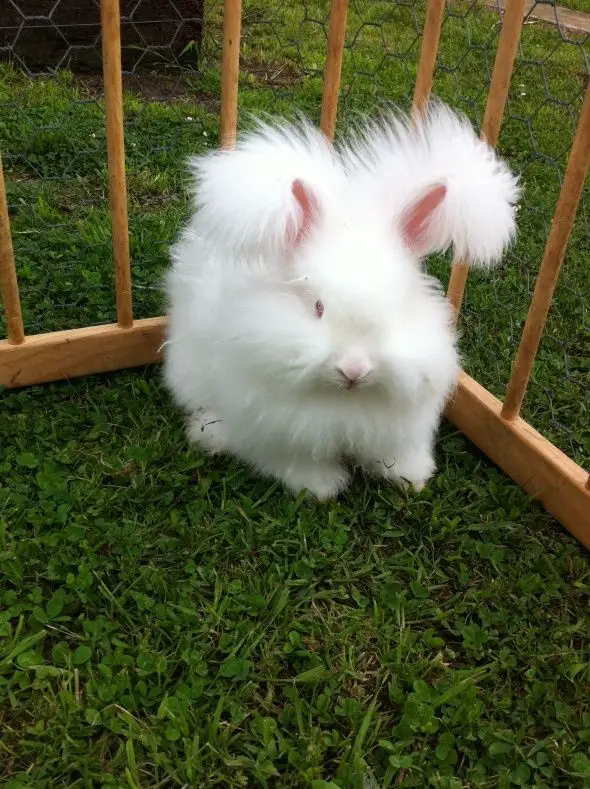
The cage for English Angoras should be made of wire and a strong metal or wooden frame. The bottom must be removable where the rabbit’s poop will fall. A removable pan makes it easier to clean and maintain the cage. The floor of the enclosure should be lined with soft bedding or fresh hay. You may use hay, wood pellets, or pelleted bedding.
To clean the enclosure, remove your pets and place these in a safe and clean container, box, or cage. Use a safe cleaner or natural cleaning product like white vinegar, baking soda, and water or lemon juice. Never use ordinary household cleaners because these contain toxic ingredients that can be dangerous to your pet.
Have a separate or extra cage to raise baby English Angoras. When baby Angoras are born, these are party-naked, deaf, and blind and very much vulnerable to predators. These need a warm enclosure to keep their bodies at the right temperatures and to be safe as they grow older. Place these mini Angoras in a smaller cage with cage lamps or lighting to keep them warm and safe.
And similar to other breeds, English Angoras will chew on things. If these are kept indoors, these will chew on anything made of wood, such as wooden walls, fixtures, and furniture. You need to make sure that your home is rabbit-proof before releasing your pet rabbit from its cage.
Health Concerns
An English Angora is a healthy breed and is not affected by any disease. And possibly the most common conditions that the English Angora may be affected with are pests because these can be naturally found in their environment.
Meanwhile, English Angora rabbits are not immune to common diseases. This is why you must monitor your rabbit’s health and temperament because any change can be due to an illness. So, as early as your pet can open its eyes and wean from their mother, take it to the vet for vaccinations and basic tests.
These basic tests will assess the overall health and development of your rabbit. Also, consider that there are rabbits that are prone to different health conditions that affect the digestive tract, such as enteritis, bloat, and stasis. These are common in rabbits that are less than two months of age.
Watch out for ear or fur parasites, and the most common are mites, fleas, and ticks. Specimens that harbor these parasites usually have poor hygiene and are in dirty surroundings and enclosures. This is why you should clean your pet’s cage at least every week
Check your rabbit for signs of illness such as poor appetite, diarrhea, constipation and vomiting, and nasal and eye discharges. You should also assess for an unsteady gait, restlessness, teeth grating, and sleeping for extended periods because these may be signs of a serious condition.
Another important part of taking care of rabbits and other pets is deworming. Your English Angora should be treated for worms at least once a year during springtime and fall. This is a major concern, especially with rabbits that are from the wild or are bred from wild rabbits.
All rabbit breeds must be dewormed using a deworming paste; a pea-sized amount will do. Place this small amount of deworming paste in the rabbit’s mouth, and surely it will continuously lick and swallow the medication. Follow the dose according to your vet’s prescription.
Dental Care
A rabbit’s teeth will grow longer, and sometimes, their teeth can grow to extreme lengths that it can pierce the mouth and gums. When this happens, your rabbit will experience so much pain and discomfort. As an owner, make sure that the rabbit’s teeth won’t overgrow.
You can assist your rabbit by offering hay because these files down the rabbit’s teeth as the rabbit chews. You may also place pieces of wood, wooden baskets, or other accessories that can file the rabbit’s teeth. Monitor your rabbit’s dental health so you can save on expensive dental bills.
Spaying or Neutering
Rabbits can be very promiscuous, and any responsible pet owner will control this by spaying or neutering their pets. Spaying and neutering should be done at a young age. Some veterinarians wait until the rabbits are six months, and bucks are also neutered at a young age because neutering reduces aggression. Some vets neuter males as young as three months, but different vets have different recommendations. For any question regarding spaying and neutering, consult your vet any time.
Grooming
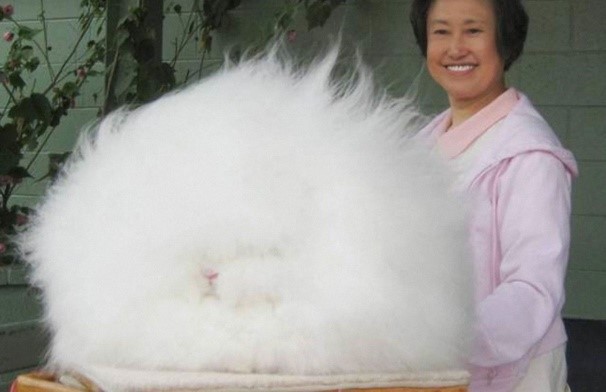
English Angoras have very long furs and will need a groomer to keep its coat healthy and perfect. This rabbit will need regular grooming. Brush the fur to keep it clean, shiny, and well-maintained. Groom this with a durable brush at least every week.
Grooming must be done more frequently, especially during the molting period, to prevent wool blocks and keep the rabbit from eating their fur. This can accumulate in the digestive tract, which can lead to blockage and more complications.
Don’t bath your rabbit because this can cause stress. Use a damp towel to spot clean the dirt away and just wipe the rabbit down with the towel and use a dry one afterward.
Trim your rabbit’s nails and check its mouth for overgrown teeth regularly. The ears need grooming and cleaning weekly, so its best to visit a vet for these.
Availability – Where to Get One?

The cost of buying an English Angora may depend on whether you want a rabbit from a breeder or a retailer. The price varies whether you are getting one for a pet or show. You can expect the price to change depending on gender, size, coat color, coat quality, and appearance.
And when you are looking for a reliable breeder, be sure that you are getting a healthy one and with no genetic disorder. Purchase rabbits from a reliable breeder who raises healthy English Angoras. Also, this breed is available in trade fairs and events. There are also shows and contests by the ARBA that feature the English Angora.
How to Care for an English Angora
This is a summary of how to care for an English Angora breed. Caring for this breed is just like caring for other breeds. There are basic components of its care: a correct diet, housing, companionship, and medical care.
The main food of captive-bred rabbits is hay. You may also use rabbit pellets, vegetables, and fruits for a well-rounded and healthy rabbit diet.
Keep water and hay available inside the cage. Hay is rough and is the best in keeping their digestive tracts healthy and regular. Put water in a large, heavy shallow dish so that your rabbit can drink from it. It won’t knock it over as it moves inside the cage because this is very heavy.
Take note that captive-bred rabbits can become a calm, friendly, and happy pet when you take time to train it. It would help if you train and interact with your pet every day. Also, captive rabbits are social animals and will be happy to have a rabbit companion or companions.
Don’t forget to take your pet to the vet. It needs vaccinations, tests, and a clean bill of health before it can be allowed to associate with other rabbits, your pets, and people. Keep in mind the different signs of illness, and for any symptom spotted, take it to the vet for the right care.
FAQs
What do English Angoras eat?
English Angoras will eat plants. These will eat plant parts like roots, bark, seeds, and leaves, and it can eat commercially-prepared rabbits such as pellets, vegetables, and fruits. Overall, a pet rabbit has to have a well-rounded diet to remain healthy.
Should you pick a wild rabbit from the forest?
Never pick a wild animal such as a rabbit from the forest. You can’t tame this, and it will remain wild. If you see an injured bunny, you may call animal services for help right but never take it home.
Are English Angoras endangered?
No, English Angoras are not endangered, and this rabbit is available from local and international breeders and in pet shops and human homes as pets.
Can English Angoras swim?
Yes, English Angoras are just like other rabbit breeds, and it can swim. But this may not be as good as other water animals. Also, keep in mind that rabbits do not want to get wet, and thus swimming may not be their favorite activity.
Where do English Angoras live?
You won’t find an English Angora in the wild because these are a domesticated breed of rabbits. These prefer to live in human areas and breeding kennels, pet stores and in human homes as a pet. For English Angora pets, these may be housed in large cages indoors or outdoors in groups for companionship.
Can you keep an English Angora as a pet?
Yes, you can keep an English Angora as a pet because it has a docile and sweet temperament. It is a good pet for families but not for young kids because of its grooming requirements and care.
Do you place an English Angora’s cage indoors or outdoors?
The location of a rabbit’s cage may fully depend on you. You may place the cage of your pet indoors to protect it the rain, cold, and sunlight, but most indoor cages are small and may not be enough for a large, adult English Angora. When you place the cage outdoors, the rabbits may need to deal with the sun, cold, and rain, but these will have a large area for playing.
How large should an English Angora’s cage be?
An English Angora must be placed in a large enclosure because of its medium size and energetic nature. For two large rabbits, double the size of this enclosure. You must never overlook the size and make sure that your rabbits have enough space to play, eat, and sleep no matter how many pet rabbits you have.
Are English Angoras carnivorous?
No, these lovely rabbits are not carnivorous and are herbivores, which means that these won’t eat meat. It will only consume plants or plant parts, rabbit pellets, fruits, vegetables, nuts, and seeds.
Will English Angoras eat their poop?
Yes, just like all rabbit breeds, English Angoras will eat their poop because they know that this still has nutrients in them. After eating their droppings once, these won’t do it the second time. You can prevent this by removing their droppings ASAP.
Can you keep more English Angora rabbits inside a cage?
Yes, you can keep more rabbits in one cage as long as the cage is large enough to keep all your pets in. Take note that the cage should be large, comfortable, and safe, even if you prefer an indoor or outdoor cage.
How do you clean an English Angora’s cage?
First, you must remove the rabbit inside the cage and place it in a clean cage. Replace the pan where the poop is found and dispose of the droppings appropriately. Use a hose, brush, and cleaning product to maintain the cage walls, bottom, accessories, and rabbit toys. Everything must be dry before placing your pet back inside its cage. Replace its beddings and never reuse them.
Do English Angoras need a heater inside their cage?
You can use a cage lamp to provide heat, but in extremely cold climates, use a small portable heater and place this inside the rabbit cage for a comfortable area for your pet. This setup is also preferred for warming baby rabbits.
Can English Angoras escape their cages?
Yes, despite the size and the fuzziness of an English Angora, this can still escape their cages by kicking or knocking this down. These can’t jump over and escape but will use force to escape as well.
How do you tame a wild rabbit?
A wild rabbit is different from a captive or domesticated rabbit in such a way that this cannot be tamed. You can tame a captive-bred rabbit instead because these rabbits have a docile behavior and are calmer. But these may still need constant handling and interaction to remain tame, happy, and healthy even in captivity.
Do English Angoras eat fruits and vegetables?
Yes, English Angoras will be able to eat fruits and vegetables. You may also feed your English Angoras commercially-prepared pellets or rabbit food that usually contains nutrients that your pet needs every day.
How do you take care of baby English Angoras?
If you want to take care of baby English Angoras, put the babies in a comfortable and warm cage. Feed them soft, pureed food and keep these safe and warm. Protect from predators by ensuring that the enclosure is shut and locked. For wild-caught bunnies, call animal services to rescue these wild babies properly.
Can you leave an English Angoras indoors to play in your home?
You may allow a rabbit to remain indoors but under your supervision. One way to limit the area where rabbits can roam is by using a portable perimeter fence to keep off areas that the rabbit can’t go. Also, rabbit-proof your home before you let your rabbits free inside your home.
Will a mother English Angora eat her babies?
Some rabbit species will eat their young. Experts say that this is if you spot mother rabbits doing this, she should be removed from the nest and should not be allowed to breed again.
Can rabbits tolerate the cold?
Yes, rabbits may tolerate the cold and survive by foraging food that’s under the snow. Rabbits may use their short legs to dig out snow and eat roots, shrubs, berries, and other food which they can find hidden under snow.
Can English Angoras stay outdoors?
A pet English Angora may be allowed to stay outdoors, but you must rabbit-proof your yard before releasing them. A portable perimeter fencing is a good way to limit the area where the rabbit can roam. You must bury the fence poles so your pets can’t dig them out and escape.
What happens when the teeth of a rabbit grow longer?
When the teeth of a rabbit grow longer, these can pierce its mouth and gums, and this can be very painful. It can also affect your pet’s appetite. This is why your pet rabbit must have regular dental checks. Feed it hay since this can grind their teeth shorter as they chew.
Do English Angoras have good hearing?
Despite the English Angora having fancy and fuzzy ears, this has good hearing. It can hear predators from far away, and thus, it can jump away, hide, and escape the threat.
Can rabbits see well in the dark?
Despite the fur all over the Angora’s face, this rabbit has good vision, especially at night. This is the reason why some species look for food at night. Rabbits like the English Angora also have a good sense of smell and hearing, which also adds to its impressive characteristics in evading predators.
How often do rabbits should visit the vet?
Rabbits should visit the vet once or twice a year. Young rabbits must be vaccinated against rabbit diseases as early as possible. These must have an initial visit to a vet when they are just a few weeks old.
Are English Angoras bites fatal to humans?
Yes, English Angora bites are dangerous because rabbits may have rabies. Also, rabbit ears are huge and can easily tear off the flesh, and this can cause an infected, deep wound.
Are English Angoras territorial?
Like other rabbit breeds, English Angoras may become territorial when these are kept in a small cage or enclosure. Males may develop aggressive behavior and may become very dangerous to other males, especially during the breeding season. These can bite, scratch, and kick in an attempt to take hierarchy.
Can you prevent an English Angora from eating his poop?
You can avoid a rabbit from eating poop by removing their droppings right away. But no matter what, these animals will still eat their poop because they know that it still has nutrients.
Are all female rabbits cannibals?
Eating their young is seen in some rabbit breeds. Experts say that this is because the female is hungry or thirsty inside its cage right after giving birth. Eating stillborn babies is a way to remove any traces of tissue, blood, and smell in the nest.
How young are rabbits spayed or neutered?
This depends on the vet as to when to spay or neuter a pet. Some bucks are spayed for 3 months, while some vets will wait until the rabbits are 5 to 6 months old.
Can you train your rabbit to walk with a collar and leash?
Some owners are successful in training their pet rabbits to wear a collar and walk on a leash, but some say that it depends on the breed. You may train a calm and docile breed but not a skittish one.
Does it hurt when an English Angora scratches you?
Yes, English Angoras have very sharp claws, especially on its hind feet. The rabbit can kick very hard with its hind feet, and this can inflict damage. The rabbit will only do this when it feels threatened.
Can rabbit diseases affect humans?
Some rabbit diseases can affect rabbits, and some are dangerous to humans so you need to take your pet to the vet as soon as you see that it is sick You must learn to identify the different signs of illnesses such as poor appetite, diarrhea, constipation, sneezing, problems with breathing and changes in behavior.
Will English Angoras recognize their owners?
Some rabbit owners say that their English Angoras can recognize them and can tell if they fed and handled by their owners.
Can rabbits tolerate children?
Some rabbits are skittish and don’t want to be held by unsteady hands like young children. Some are calm, docile, and friendly and won’t mind if they are petted by young children.
How many rabbits are you able to keep as pets?
You can keep more rabbits as a pet as long as you have a large cage or enclosure to keep all your pets comfortable and happy. Having one rabbit will make it lonely, and this can cause stress and affect its health.
Will rabbits eat insects?
No, rabbits will never eat insects. This animal will eat only plant and plant parts, rabbit pellets, fruits, and vegetables. Be sure to provide organic produce only to avoid chemicals and toxins, which can affect your pet’s health.
Where do rabbits sleep in the wild?
In the wild, rabbits may sleep inside warrens or deep holes or burrows. Rabbits will dig holes as deep as a meter and stay inside all day. In captivity, they must live in a comfortable cage that can accommodate a group of rabbits and is safe and secure from predators.
Will your pet rabbit survive the cold?
Yes, a pet rabbit can survive the cold. Wild rabbits will even find food under the snow while some wilds can change their fur color to adapt to the winter climate. Meanwhile, some may not survive the cold like desert rabbits.
Can you place the cage of English Angoras near other rabbits?
You can do this, and this is the setup in most pet shops and stores. English Angoras are known as very friendly, docile, and calm; therefore, meeting other rabbit breeds won’t be a problem for them.
What do you do with abandoned baby rabbits?
For wild kits abandoned in their nests, contact animal service. Don’t get baby rabbits from the wild to raise as pets.
